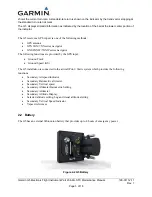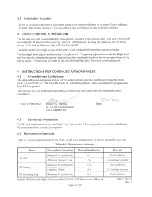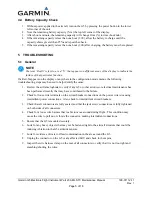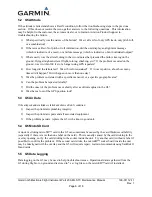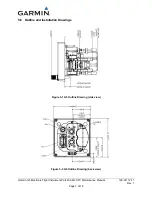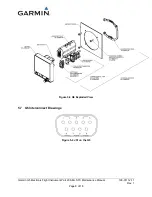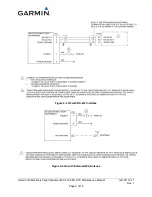
Garmin G5 Electronic Flight Instrument Part 23 AML STC Maintenance Manual
190-01112-11
Rev. 1
Page 17 of 18
7.5 G5 Calibration Procedures
Table 7-2
describes the calibration procedures to be performed for the G5 unit after maintenance is
performed.
Table 7-2: Calibration Procedure Summary
Calibration
Procedure Procedure
Name
Procedure
Description Requirement
A
Pitch/Roll Offset Compensation
Level aircraft
Procedure A is required if a new
G5 unit is installed
C
Air Data Static Pressure
Calibration
Altitude calibration
Procedure C is recommended if
the G5 altimeter does not match
primary altimeter
7.5.1 Calibration Procedure A: Pitch/Roll Offset Compensation
NOTE
This procedure requires orienting the aircraft to normal flight attitude. This can be done by
using jacks or placing wood blocks under the nose-wheel, for example. As another example, if
the number of degrees ‘nose high’ the aircraft flies in straight and level cruise is known, a digital
level can be used to orient the aircraft to normal flight attitude prior to the calibration.
NOTE
The G5 must be leveled within 15.0° of the aircraft in-flight level cruise attitude. In-flight level
cruise attitude is not necessarily the same as the level reference provided by the manufacturer
(such as fuselage longerons).
1.
Select the Attitude configuration page.
2.
Select Calibrate Pitch/Roll.
3.
Ensure that aircraft and the unit comply with all on-screen instructions then select Start.
4.
A progress screen will then be displayed. There is a 30 second countdown timer for the procedure
that resets when the aircraft moves.
5.
When the calibration is complete, a successful status message will be displayed along with the
new pitch and roll offsets.
7.5.2 Calibration Procedure C: Air Data Static Pressure Calibration
The Air Data configuration page has a selection for static pressure calibration. This procedure is used to
perform an altimeter re-calibration. The altitude pressure sensor used in the G5 is very low drift and does
not typically require re-calibration.
The static pressure calibration requires the use of a pressure control system (test set) with an altitude
accuracy of at least ±5 ft. at sea level and ±20 ft. at 30,000 ft. It is necessary to re-calibrate to sea level (0
ft.), 10,000 ft., 20,000 ft., and optionally to 30,000 ft. The operator is allowed to finish the calibration at
the end of the 20,000 ft. calibration if the aircraft operational ceiling is below 20,000 ft.
Summary of Contents for Approach G5 - GPS-Enabled Golf Handheld
Page 11: ......

